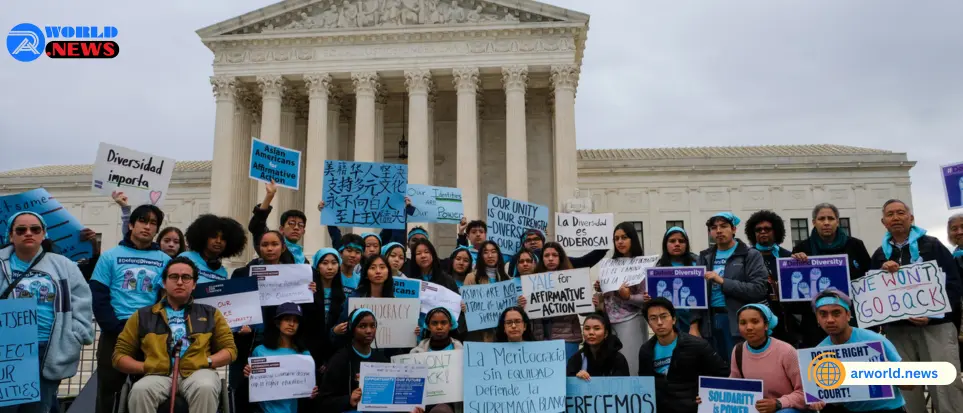Undergraduate Admissions Following The 2023 Supreme Court Verdict: Q&A
Earlier today, MIT Admissions revealed demographic data for the undergraduate Class of 2028, the first class admitted following the Supreme Court’s ruling in Students for Fair Admissions (SFFA) v. Harvard, which prohibited the use of race in undergraduate admissions. As Dean of Admissions and Student Financial Services Stu Schmill ’86 predicted in a blog post last June, the court’s decision has resulted in a decrease in the number of first-year students who come from historically underrepresented racial and ethnic groups.
MIT News spoke with Schmill about the shift, why diversity is important in MIT education, and what comes next. Schmill also posted a personal reflection on the MIT Admissions blog.
Q: How will the Supreme Court’s judgment affect the MIT Class of 2028?
The Supreme Court declared last June that federally funded colleges and universities may no longer consider race in undergraduate admissions decisions. As I stated in a blog post at the time, we anticipated that this would result in fewer students from historically underrepresented racial and ethnic groups enrolling at MIT. That’s what occurred.
As a baseline, in recent years, around 25% of our undergraduate students have identified as Black, Hispanic, Native American, or Pacific Islander. That figure applies to the incoming Class of 2028 at around 16%. (According to federal data, 45% of K–12 pupils in American public schools belong to one of these groups.)
While this is a significant shift in the demographic composition of the Class of 2028 compared to previous years, I want to emphasize that it has no aggregate impact on the quantifiable characteristics we use to predict academic success at MIT, such as high school performance or standardized test scores. According to these indicators, this cohort is equally poised to flourish in our program as other recent classes that were more diverse.
I underline this important point since many individuals have informed me throughout the years that MIT should only focus about academic success and not diversity. However, every student we enroll, regardless of circumstances, is already at the far right end of the academic excellence spectrum. During my tenure as dean, we only accepted applicants who met our exceptionally high standard of academic preparedness. Recognizing the significant educational benefits of diversity, we attempted to create a class from that highly qualified group that reflected both breadth and excellence in terms of collective interests, aptitudes, and experiences.
Our accomplishments on and off campus demonstrate our success in achieving academic excellence and broad diversity. As MIT has become more diverse in recent years, aggregate academic performance, as well as retention and graduation rates, have improved to all-time highs for students from all backgrounds. According to data from the American Society for Engineering Education, during the previous ten years, MIT has graduated more engineers from historically underrepresented racial and ethnic groups than any other private college or university. (and practically all public colleges in the United States), while also being largely considered the world’s leading STEM institution and a key source of innovation. Our community’s simultaneous achievements demonstrate a synthesis of diversity and greatness, rather than a conflict between the two.
Q: Why is diversity important in an MIT education?
Based on empirical facts and personal experience, I am confident that MIT education is most effective when our student body is broadly varied, above and beyond a high standard of academic achievement.
Any MIT graduate will tell you that they learnt just as much from their peers as from their instructors; that was certainly true for me as a Course 2 [mechanical engineering major] in the 1980s, as it is for my advisees now. When you bring together people with diverse perspectives and experiences who have common interests, aptitudes, and a commitment to MIT’s goal, they contribute their own gifts to collective success.
We also need variety to attract the top students. As MIT has become more diverse, more of the most talented students in the country from all backgrounds have chosen to enroll, and they particularly tell us in surveys that attending a diverse university is important to them and that they value this aspect of their MIT education.
It is not a surprise that today’s students desire a diverse campus community; they represent the most multiracial, multiethnic, and multicultural generation of Americans in history. Another reason we value diversity is because it helps us attract the best talent for the next generation of scientists, engineers, and knowledge creators.
Q: Why did MIT have to consider race in the past to achieve diverse classes?
A: As we stated in our amicus brief in the SFFA case, the educational benefits of diversity are well known. Empirical research shows that what matters for creativity and innovation is a team of highly qualified people with diverse experiences and backgrounds working together to produce novel solutions to difficult issues.
Unfortunately, there is still ongoing and deep racial inequity in American K–12 education, particularly in STEM. This means that carrying the variety of American public schools into higher education is challenging from the start.
Let’s begin with these unsettling facts. According to federal data, among public high schools where 75% or more of the students are black or Hispanic:
Many schools do not provide calculus, computer science, or physics courses.
According to research, kids who do not have the opportunity to develop a good foundation in math and science in high school are significantly less likely to graduate with a STEM degree. Meanwhile, Stanford University’s Educational Opportunity Project found that school segregation, which is strongly linked to achievement differences, has consistently expanded since the early 1990s. By some measurements, school segregation has reached levels not seen since Brown v. Board of Education 70 years ago.
In our daily work at the MIT Admissions office, we witness directly the startling amount of ongoing educational disparity in the United States. Whether we are on the road or at home perusing applications, we may observe disparities in opportunities from state to state, district to district, school to school, and even within schools.
We’ve tried to help address these gaps by pointing prospective students to free materials that can help them better prepare for college-level STEM work, whether at MIT or elsewhere. In my blog article today, I discuss MIT’s long tradition of providing educational opportunities to students from diverse backgrounds. I believe MIT can, will, and must do even more to open a window of opportunity in the future.
Q: What does all of this mean?
Prior to the SFFA decision, we could utilize race as one of several factors to identify well-prepared children who emerged from an unequal K–12 educational environment. We could see that these individuals met our high academic criteria, were a good fit for our program, and would thrive at MIT.
Following the SFFA judgment, we are no longer able to use race in the same way, which is reflected in the Class of 2028 outcome. We did not collect racial or ethnicity information from candidates this year, so we do not have data on the applicant pool. However, I am confident that we excluded many well-qualified, well-matched applicants from historically underrepresented backgrounds who would have been admitted and flourished in the past.
I’d like to underline that this shift in the composition of our incoming class is not attributable to our restored testing requirement. In fact, the class we admitted last year under the testing requirement had the highest proportion of students from historically underrepresented racial and ethnic backgrounds in MIT history, thanks to universal testing, which allowed us to identify objectively well-qualified students who lacked other opportunities to demonstrate their preparation. As I stated at the time, standardized examinations are undoubtedly imperfect, but they are, in significant ways, less uneven than other options.
We will continue to use the tests to help identify students who could not otherwise demonstrate their readiness for our education; however, the SFFA decision limits our ability to select a class from among the well-qualified pool of applicants that intentionally draws from a diverse range of backgrounds.
Q: Where will MIT go from here?
Given the demonstrated educational benefits, we continue to evaluate many types of diversity, including future fields of study and research, extracurricular activities and accomplishments, as well as economic, geographic, and educational backgrounds—but not race.
Following the ruling, we enhanced recruitment and financial aid activities aimed at increasing access to MIT for students from all backgrounds. These efforts include a new focused outreach campaign that identifies and encourages students from rural America to apply to MIT. They also include a new policy in which most families earning less than $75,000 per year pay nothing to attend—the type of unambiguous commitment that has been demonstrated to reduce barriers. It has enabled us to quintuple the number of students we match via QuestBridge, a nationwide talent search initiative for high-achieving, low-income adolescents of all backgrounds. This underscores the MIT leadership’s ongoing commitment to making our education affordable to all through the $165 million we invest annually in undergraduate financial aid.
Clearly, we still need to do more to guarantee that MIT remains a magnet for top talent from all backgrounds. My team has been meeting with teacher, student, and administrative leadership to brainstorm potential future initiatives. And in her community statement today, President Kornbluth emphasized her commitment to making an MIT education available to those “whose talent and potential have been masked or limited” by institutional and societal circumstances. This was the allegation of the Task Force on Educational Opportunity convened by former MIT president Paul Gray in 1968. Through this continuous effort, we hope to determine the best course ahead for the Institute of today and future generations.
To be clear, there is no simple “hack” to address racial inequity. But MIT does not shy away from difficult problems in science or society, and we will do everything we can, within the limits of the law, to continue providing an extremely rigorous and inclusive educational experience that our current, previous, and future students can be proud of.




